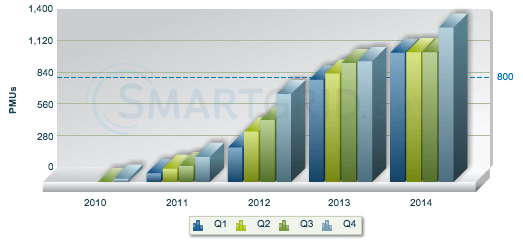Electric transmission systems carry large amounts of power at high voltages from generators to substations. Transmission systems must be kept highly reliable to prevent blackouts and ensure robust energy markets. Synchrophasor technology has emerged as key enabler for improving transmission reliability and operations. Phasor measurement units (PMUs), phasor data concentrators (PDCs), wide area communications networks, and advanced transmission applications are building blocks of a smarter and more reliable transmission system. This chart shows number of PMUs deployed as part of the SGIG program and the approximate extent of coverage in the United States resulting from SGIG funding.
SGIG Phasor Measurement Units (PMUs) Installed and Operational
Deployed as of March 31, 2015

** Number of entities reported: 13
Updated on March 13, 2015
The table below includes SGIG program transmission system expenditures.
SGIG Program Electric Transmission Asset Expenditures
Deployed as of December 31, 2014
Updated March 11, 2015
|
Electric Transmission System Assets |
Quantity* |
Incurred Cost** |
Number of Entities Reporting*** |
|
PMUs |
1,361 |
$87,918,000 |
13 |
|
Phasor data concentrators |
168 |
$14,754,612 |
13 |
|
Transmission lines with dynamic line rating systems |
0 |
$0 |
0 |
|
IT hardware, systems, and applications that enable transmission functionalities |
|
$100,623,154 |
30 |
|
Advanced applications |
|
$77,442,983 |
14 |
|
Other transmission related costs |
|
$220,822,813 |
24 |
|
Total transmission installed cost |
|
$501,561,562 |
24 |
* In some circumstances, costs were
incurred before devices were installed resulting in a reported cost where the quantity is
zero.
Projects only reported data on devices they planned to install. Each project installed
equipment that best supported their individual goals. Therefore, the number of projects
reporting is expected to vary by equipment category. The individual project reporting pages
show what equipment that project installed.
** All dollar figures are the total cost, which is the sum of the federal investment and cost share of the recipient (the recipient cost share must be at least 50% of the total overall project cost).
*** In some cases the number of entities reporting was greater than the total number of projects funded by the Recovery Act because some projects had multiple sub-projects that reported data. View list of sub-projects.
Projects
The location, information, and data for each smart grid project are provided in this section.Click for Projects
Publications
These reports include analysis, impacts, lessons learned, best practices, analytical tools, and case studies that were supported by the Recovery Act Smart Grid Programs.Click for Publications

